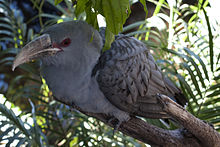Channel-billed cuckoo
| Channel-billed cuckoo | |
|---|---|
 |
|
| adult | |
| Scientific classification | |
| Kingdom: | Animalia |
| Phylum: | Chordata |
| Class: | Aves |
| Order: | Cuculiformes |
| Family: | Cuculidae |
| Genus: |
Scythrops Latham, 1790 |
| Species: | S. novaehollandiae |
| Binomial name | |
|
Scythrops novaehollandiae Latham, 1790 |
|
The channel-billed cuckoo (Scythrops novaehollandiae) is a species of cuckoo in the Cuculidae family. It is monotypic within the genus Scythrops. The species is the largest brood parasite in the world, and the largest cuckoo.
It is found in Australia, Papua New Guinea and Indonesia; additionally, it is vagrant in New Caledonia and New Zealand. The species is migratory over part of its range. There are three subspecies, one migratory, the other two resident. The species is listed as least concern by the IUCN.
The only member of the genus Scythrops, the channel-billed cuckoo was first described by ornithologist John Latham in 1790. Its generic name is derived from the Ancient Greek skuthro-/σκυθρο- 'angry' or 'sullen', and ops/ωψ 'face', 'eye' or 'countenance'. The specific epithet novaehollandiae means of New Holland, hence Australian.
There are three subspecies: the nominate Scythrops novaehollandiae novaehollandiae of Australia, New Guinea and the Moluccas, Scythrops novaehollandiae fordi in Sulawesi, and Scythrops novaehollandiae schoddei in the Bismarck Archipelago.
The channel-billed cuckoo is the world's largest cuckoo, measuring between 58–66 cm (23–26 in) long and weighing between 550–935 g (1.213–2.061 lb). 24 adults were found to have averaged 684 g (1.508 lb) in body mass. The bill is bi-coloured, with a grey base becoming straw-coloured at the tip. The bill is large slightly curved and reminiscent of the bills of hornbills; in fact, the bird is sometimes erroneously referred to as a hornbill. The plumage of the adult is pale grey on the head, chest, belly and back, becoming paler and barred lower down on the belly. The wings are darker grey with dark tips on the feathers. The tail is dark grey on top and barred underneath with a black band and white tip at the end. The feet and legs are black, and the eye is surrounded by prominent red skin. While most other very large cuckoos are rather terrestrial (i.e. roadrunners or the Neomorphus genus), the channel-billed cuckoo is fairly arboreal and is capable both in trees and on the ground. The channel-billed cuckoo is a strong flier, with a distinctive, almost hawk-like cruciform flight silhouette. In flight the wingspan is around 1 m, with the wings held stiffly. There is some sexual dimorphism in both plumage and dimensions, the female having a smaller bill and paler, more barred undersides.
...
Wikipedia

